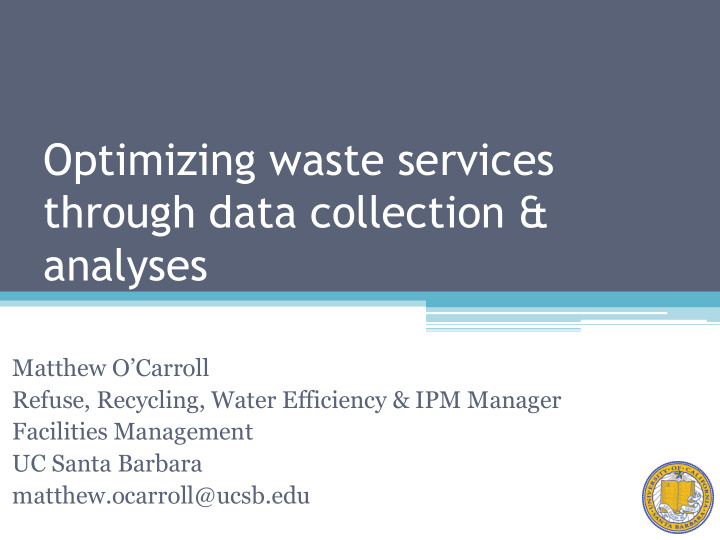



Optimizing waste services through data collection & analyses Matthew O’Carroll Refuse, Recycling, Water Efficiency & IPM Manager Facilities Management UC Santa Barbara matthew.ocarroll@ucsb.edu
Roadmap ▪ UCSB at a glance ▪ Indoor Waste Infrastructure ▪ Background: Building on failure ▪ Real Stakeholder Engagement ▪ Designing the pilot ▪ Implementation ▪ Results ▪ Rightsizing Waste Hauling Schedules ▪ Making your hauling schedule work
Interior Waste Services & Infrastructure
Custodial Service at UCSB ▪ 110 custodial staff members tasked with cleaning indoor spaces (offices, labs, restrooms, etc.) ▪ Clean over 3M ft2 (1,300 average-sized houses) ▪ Each custodian cleans ~13 houses/ shift ▪ 80% of the staff work between 2am – 10:30am ▪ Waste Services (Trash and Recycling) ▪ Daily: Common areas (hallways, kitchens, restrooms, etc.) ▪ 1x/ week: Private offices and workspaces ▪ Trash: Serviced by custodians ▪ Recycling: Serviced by office occupant at nearest common bin ▪ 3x/ week: Labs
Background: Building on Failure ▪ Received a TGIF grant to purchase over $5,000 desk-side recycling bins ▪ Swap clip-on with new desk- side bin ▪ Switch in custodial service ▪ Custodian: Recycling 1x/wk ▪ Office Occupant services trash at nearest centralized bin
Background: Building on Failure (cont.) ▪ Custodial staff and office occupants notified of changes – D-list, note cards, trainings, meetings, etc. ▪ Results ▪ Largely welcomed but with pushback from several vocal and notable professors, mobilizing their departments ▪ New Opportunity ▪ Landlord v. Customer Service ▪ Turning a negative into a positive
Stakeholder Engagement & New Standard ▪ Determine the real needs of the building occupants ▪ Spend time with the custodial staff ▪ “We can service both waste streams”
The Pilot of the Pilot ▪ Pilot of the pilot – Walk one building to determine pilot methodology ▪ Work with staff to identify inefficiencies and weaknesses ▪ Findings/ Issues: ▪ Outdated waste infrastructure ▪ Excess waste receptacles ▪ No logic to waste infrastructure or documentation ▪ Unclear service schedules ▪ Inadequate equipment
Pilot Project - Outline Walk 10 buildings of various types with their respective custodial staff on their normal routes ▪ Building types: administrative, academic, laboratory, student center, athletics ▪ Start times: Fridays at 4am ▪ Wednesdays at 4pm ▪ “The Team”: Assoc. Director of FM, Sr. Custodial Superintendent, Waste Manager, Waste Intern
Pilot Project – Equipment Upgrades Blue liners for recycling New custodial trains receptacles
Pilot Project – Equipment Upgrades New standard for landfill and Signage for each bin on- recycling receptacles campus Custodial Service Custodial Service MONDAY DAILY
GA Classroom Waste Receptacles ▪ Removed waste receptacles (trash and recycling) from all General Assignment classrooms ▪ Exception – Large lecture halls ▪ Ensured receptacles outside of classroom were adequate for volume ▪ Posted signs and sent email blasts
Mapping Changes Indoor waste receptacle map
Results - Quantitative ▪ 352 landfill receptacles were removed ▪ 285 (10gal), 67 (+23gal) ▪ ~47,060 liners will be saved ▪ 876 lbs. ▪ Reduction service time of waste receptacles = 393 hrs/ yr. ▪ Estimated reduction in contamination of 12%
Results - Quantitative
Results - Qualitative • Improving employee welfare ▫ Time spent with the custodial staff ▫ Empowerment • Less waste receptacles = more time to clean and beautify high traffic areas • Potential to reduce work related injuries due to bending over
Next Steps • Biannual audit of interior infrastructure by custodial supervisors ▫ Inventory is provided to custodial staff and building managers • Supervisors will now use IPad to track changes ▫ Google Drive – Google Sheets vs. PDF Expert
Right-Sizing Waste Hauling Schedule (Dumpsters)
On-board Data Collection • Contract haul with MarBorg Industries • Loadman ▫ Included in language in hauling contract ▫ On-board scale system mounted on forks ▫ Route is loaded into system and directs driver to next location ▫ Provides real-time data as bins are collected ▫ Data returns to Loadman system and can be exported
Data Management & Analyses • Aggregated 1 year worth # Service Lbs/Service Bin size Location Average Service Days Days Days (yd 3 ) of waste hauling data 985.62M-W-F-- 3 82.13 4 Embarc H 1036.46M-W--S- 3 86.37 4 Kerr • Targeted dumpsters with 1260.08M-W-F- 3 105.01 4 Coun/Ca Lbs 1365.69M-W-F 3 113.81 4 EH&S 3+ services per week 1457.31M-W-F-- 3 121.44 4 Noble Hall 1467.54M-W-F- 3 122.29 4 Bren • Focused on service 1535.69M-W-F-- 3 127.97 3 Rec 1690.54M-W-F-- 3 140.88 4 GGSE reduction and seasonal 1759.92M-W-F-- 3 146.66 4 Psych Lbs variations 1786.23M--H-S- 3 148.85 4 HSSB Lbs 1852.08M-W-F-- 3 154.34 4 Pollock 2096.62M-W-F-- 3 174.72 4 • Estimated to save ~$30k Marine Bio 2096.92-T-H-S- 3 174.74 4 Arts in hauling fees/ year 4180.46MTWHF-- 5 209.02 4 Cheadle Lbs
Challenges • Hauler owns Loadman hardware and software • Currently only installed on two trucks • Data is not provided in real-time • Weight was the only quantitative measurable, surveyed staff for volume
Next Steps • Continually monitor weights from Loadman software • Establish seasonal hauling schedule • Determine if UCSB can have access to data • Investigate real-time technology for hauling, Compology
Questions
Recommend
More recommend